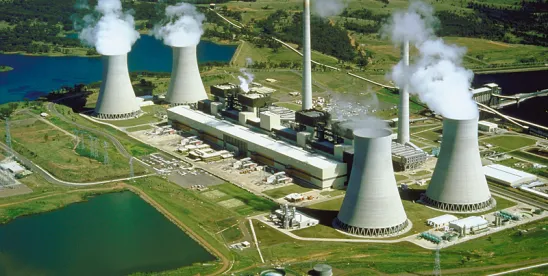The past several decades have seen minimal greenfield nuclear plant development in the U.S. Units 3 and 4 of the Vogtle power plant in Greensboro, Ga., came online in 2023 and 2024, respectively, representing the first new projects in nearly a decade. Since 1990, the only other project placed in service was Watts Bar Unit 2 outside Knoxville, Tenn., which is owned and operated by the Tennessee Valley Authority (TVA). Financing is one of the principal challenges that needs to be overcome for nuclear energy to realize its full promise and potential.

Financing Traditional Nuclear Projects: Cash (Flow) Is King
Non-recourse or limited-recourse financing for nuclear energy projects has been difficult to obtain. Traditionally developed nuclear generating assets are among the most expensive infrastructure projects. Typically in the range of approximately 1 gigawatt (GW) per unit, they are principally characterized by their technical and regulatory complexity.
Long and often-delayed permitting and construction lead to cost overruns, creating a highly unpredictable cash flow that may not be realized for 20+ years. Given the scale and capital investments involved in developing and constructing nuclear power plants, as well as the lack of greenfield development in the U.S. over the past three decades, there are few (if any) engineering and construction firms currently able to deliver projects on a lump-sum, turnkey basis.
A further complication to attracting private sector financing arises from the deregulated structure of power markets in many regions across the U.S. Debt financiers will typically look to predictability of future cashflows as a primary measure of assessing risk with any power project. For nuclear facilities in liberalized wholesale markets, this will often be difficult due to energy price fluctuations and the frequent absence of dedicated offtake terms.
Although nuclear power plants can participate in forward capacity auctions, these are generally conducted three years in advance with a limited capacity commitment period. Due to the aforementioned construction timelines, nuclear project developers are rarely in a position to bid on future capacity auctions prior to the commencement of construction.
The nature of funding required to build large-scale traditional nuclear plants severely limits - if not precludes - private investment . Governmental support has been provided in a number of different contexts. The Inflation Reduction Act (IRA) introduced a new zero-emissions nuclear production tax credit, which provided a credit of up to 1.5 cents (inflation adjusted) for projects that meet prevailing wage requirements.1 Further, the IRA’s transferability sections have allowed project sponsors the ability to unlock greater revenue streams.2 In addition to the tax credits, the IRA allocated $700 million in funding for the development of high-assay low-enriched uranium (HALEU), while the Infrastructure Investment and Jobs Act (IIJA) allocated funding for the development of modular and advanced nuclear reactors. A more direct form of project-level governmental support comes in the form of direct lending or loan guarantees. For instance, the development of Vogtle Units 3 and 4 received a $12 billion loan guarantee from the Department of Energy.
Permitting Reform Can Help
Ultimately, a stable and favorable regulatory regime would lower the discount rate and hence the required rate of return for nuclear power projects. The Trump administration has signaled its intention to promote the nuclear industry through a number of early executive actions, though legislation would likely be needed to create meaningful changes in this regard.
Notwithstanding this apparent support for nuclear energy, federal agencies have been ordered to pause the disbursement of funds appropriated under the IRA and the IIJA for at least 90 days, creating some uncertainty as to the status of funding for nuclear energy projects (as well as a broad range of clean energy projects) appropriated thereunder. Permitting reform and further funding to encourage greater development of nuclear projects receives strong bipartisan support, but is subject to delays if made part of a larger political compromise.
Permitting reform and further funding to encourage greater development of nuclear projects receives strong bipartisan support, but is subject to delays if made part of a larger political compromise.
Small Modular Reactors, Lower Hurdles to Financing and Deployment
In order to sidestep some of the technical challenges that have traditionally resulted in delays and cost-overruns, the nuclear industry has moved towards the adoption of small modular reactors (SMRs) as a means to lower delivery costs, and in turn, reduce financing hurdles. Based on the International Atomic Energy Agency’s definition, SMRs include units of up to 300 megawatts (MW) of generating capacity. There are numerous technologies currently competing under the umbrella SMR classification, but in general, these technologies allow generating assets to be largely fabricated off-site on a standardized basis, potentially reducing manufacturing costs and regulatory uncertainties, and hastening deployment of new technologies.
SMR financing is rapidly evolving. Since there are currently no operational SMR projects in the U.S., the first generation of projects to come online will require “first-of-a-kind” (FOAK) financing. This can be challenging for a number of reasons, as it will require financiers to accept the elevated risks associated with a commercially unproven technology. Government can and does derisk initial equity financing through loan guarantees and/or grants. In fact, we saw evidence of such this in 2021’s Bipartisan Infrastructure Law, in which the US Department of Energy announced $900 million in funding to support SMR deployment. Earlier this month, the TVA and American Electric Power (AEP) led an $800 million application with partners including Bechtel, BWX Technologies, Duke Energy to pursue advanced reactor projects. The substance of the proposals is to add SMRs at existing generating sites including TVA’s Clinch River site and Indiana Michigan Power’s Spencer County site. It is unclear if the Trump Administration's funding freezes and priority changes will jeopardize disbursements from this legislation, but general support for the nuclear industry appears to continue.
Since there are currently no operational SMR projects in the U.S., the first generation of projects to come online will require “first-of-a-kind” (FOAK) financing.
Even without governmental support, innovative financing structures will be available to assist in the deployment of SMR projects. A number of companies developing SMR designs are doing so together with corporate customers that plan to deploy these reactors as sole-source providers for facilities such as AI data centers. With a dedicated power purchase agreement with a creditworthy offtaker, many SMR projects will be considered bankable notwithstanding the novelty of the technology being deployed.
Conclusion
Although nuclear energy is widely seen as playing a key role in grid expansion and decarbonization initiatives, there are a number of obstacles which render financing challenging. Strong political support alongside appropriately tailored policy tools can help unlock the private capital needed to deploy nuclear energy at scale. The arrival of SMR technology will produce initial challenges with FOAK financing, but in time more predictable returns will attract the financing to permit a more widescale adoption of nuclear energy in countless use cases.
Knowledgeable and experienced legal counsel can assist with the proper structuring and risk allocation in transaction documents to help unlock financing and drive projects forward. Given the enthusiasm for the role of nuclear in supporting energy expansion, however, there is room for optimism about the opportunities for greenfield nuclear projects in the coming decades.
1 26 U.S.C. § 45U.
2 26 U.S.C. § 6417.




 />i
/>i

